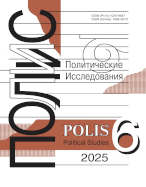Революционные события XXI века:
предварительный количественный анализ
Голдстоун Д. А.,
Доктор философии (PhD), Школа государственной политики, Университет Джорджа Мейсона, Арлингтон, США, jgoldsto@gmu.edu
ORCID: 0000-0003-1524-6081 |Гринин Л. Е.,
Доктор философских наук, Национальный исследовательский университет “Высшая школа экономики”, Москва, Россия; Институт востоковедения РАН, Москва, Россия, leonid.grinin@gmail.com
elibrary_id: 250272 | ORCID: 0000-0003-0278-2619 | RESEARCHER_ID: D-8842-2012
Устюжанин В. В.,
Национальный исследовательский университет “Высшая школа экономики”, Москва, Россия, vvustiuzhanin@hse.ru
elibrary_id: 1164721 | ORCID: 0000-0003-3800-1108 |
Коротаев А. В.,
Доктор философии (PhD), доктор исторических наук, Национальный исследовательский университет “Высшая школа экономики”, Москва, Россия; РУДН, Москва, Россия; МГУ им. М.В. Ломоносова, Москва, Россия, akorotayev@gmail.com
elibrary_id: 72980 | ORCID: 0000-0003-3014-2037 | RESEARCHER_ID: N-1160-2018
Дата поступления статьи: 2022.05.05. Принята к печати: 2023.02.08

DOI: 10.17976/jpps/2023.04.05
EDN: FSMFMK
Голдстоун Д. А., Гринин Л. Е., Устюжанин В. В., Коротаев А. В. Революционные события XXI века: предварительный количественный анализ. – Полис. Политические исследования. 2023. № 4. С. 54-71. https://doi.org/10.17976/jpps/2023.04.05. EDN: FSMFMK
Исследование выполнено при поддержке Российского научного фонда (проект № 19-18-00155).
Авторы изучают важные аспекты революционного процесса XXI века. Рассматриваются причины, по которым революционный процесс начала XXI столетия проходит довольно бурно, а также прогнозы, обещающие, что и в будущем он будет весьма активным; анализируются революционные тренды, в том числе особо тревожный – рост числа радикальных исламистских революционных выступлений. Все сказанное иллюстрируется статистическим анализом различного типа революций. Насколько авторам известно, количественных исследований революций последних десятилетий практически нет. Между тем этот анализ убедительно показывает возрастающее значение в революционном процессе в Мир-Системе африканских стран, роль которых будет увеличиваться и в дальнейшем уже по причине бурного роста населения и укрепления государственности в регионе.
Список литературы
Голдстоун Дж.А., Гринин Л.Е., Коротаев А.В. 2022. Волны революций XXI столетия. Полис. Политические исследования. № 4. С. 108-119. https://doi.org/10.17976/jpps/2022.04.09. EDN: DVNOBB.
Розов Н.С. 2019. Философия и теория истории. Кн. 2: Причины, динамика и смысл революций. М.: Красанд/URSS. EDN: ZOHXEI.
Розов Н.С., Пустовойт Ю.А., Филиппов С.И., Цыганков В.В. 2019. Революционные волны в ритмах глобальной модернизации. М.: Красанд/URSS. EDN: STNOCN.
Beck, C.J. (2011). The world-cultural origins of revolutionary waves. Five centuries of European contention. Social Science History, 35(2), 167-207. https://doi.org/10.1017/S0145553200011482
Beck, C.J., Bukovansky, M., Chenoweth, E., Lawson, G., Nepstad, S. E., & Ritter, D. P. (2022). On revolutions: unruly politics in the contemporary world. Oxford: Oxford University Press. https://doi.org/10.1093/oso/9780197638354.001.0001
Beissinger, M.R. (2007). Structure and example in modular political phenomena: the diffusion of Bulldozer/Rose/Orange/Tulip Revolutions. Perspectives in Politics, 5(2), 259-276.
Beissinger, M.R. (2022). The revolutionary city. Urbanization and the global transformation of rebellion. Princeton, NJ: Princeton University Press. https://doi.org/10.1017/S1537592707070776
Castañeda, J. (1993). Utopia unarmed: the Latin American Left after the Cold War. New York: Vintage Books.
Chase-Dunn, C., & Nagy, S. (2022). Global inequality and world revolutions: past, present and future. In Handbook of Revolutions in the 21st Century: The New Waves of Revolutions, and the Causes and Effects of Disruptive Political Change (pp. 999-1022). Cham: Springer. https://doi.org/10.1007/978-3-030-86468-2_39
Chenoweth, E., & Shay, C.W. (2020). List of Campaigns in NAVCO 1.3. Cambridge, MA: Harvard Dataverse. https://dataverse.harvard.edu/dataset.xhtml?persistentId=doi:10.7910/DVN/ON9XND
Chenoweth, E., & Stephan, M.J. (2011). Why civil resistance works: the strategic logic of nonviolent conflict. New York, NY: Columbia University Press.
Cincotta, R. (2008/2009). Half a chance: youth bulges and transitions to liberal democracy. Environmental Change and Security Program Report, 13, 10-18.
Cincotta, R, & Doces, J. (2011). The age-structural maturity thesis: the impact of the youth bulge on the advent and stability of liberal democracy. In Political Demography: How Population Changes Are Reshaping International Security and National Politics (pp. 98-116). New York, NY: Oxford University Press.
Cox, D.R., & Stuart, A. (1955). Quick sign tests for trend in location and dispersion. Biometrika, 42(1-2), 80-95. https://doi.org/10.1093/biomet/42.1-2.80
Eisenstadt, S.N. (1978). Revolution and the transformation of societies. New York, NY: The Free Press.
Filin, N., Khodunov, A., & Koklikov, V. (2022). Serbian “Otpor” and the color revolutions’ diffusion. In Handbook of Revolutions in the 21st Century: The New Waves of Revolutions, and the Causes and Effects of Disruptive Political Change (pp. 465-482). Cham: Springer. https://doi.org/10.1007/978-3-030-86468-2_17
Fukuyama, F. (1989). The end of history. The National Interest, 16, 3-18.
Fukuyama, F. (1992). The end of history and the last man. New York, NY: Free Press.
Gellner, E. (1983). Nations and nationalism. Oxford: Blackwell.
Goldstone, J.A., Grinin, L., & Korotayev, A. (2022). Conclusion. How many revolutions will we see in the 21st century? In Handbook of Revolutions in the 21st Century: The New Waves of Revolutions, and the Causes and Effects of Disruptive Political Change (pp. 1035-1059). Cham: Springer. https://doi.org/10.1007/978-3-030-86468-2_41
Goldstone, J.A. (2002). Population and security: how demographic change can lead to violent conflict. Journal of International Affairs, 56(1), 3-21.
Goldstone, J.A. (2016). Revolution and rebellion in the early modern world: population change and state breakdown in England, France, Turkey and China 1600-1850 (25th Anniversary Edition). London: Routledge. https://doi.org/10.4324/9781315408620
Goodwin, J.A. (2001a). Is the age of revolutions over? In Revolution: International Dimensions (pp. 272-283). Washington, DC: CQ Press.
Goodwin, J.A. (2001b). No other way out: states and revolutionary movements, 1945-1991. Cambridge: Cambridge University Press. https://doi.org/10.1017/CBO9780511812125
Goodwin, J. (2003). The renewal of socialism and the decline of revolution. In The Future of Revolutions: Rethinking Radical Change in the Age of Globalization (pp. 59-72). London: Zed Books.
Grinin, L.E. (2020). How can COVID-19 change geopolitics and economy? Journal of Globalization Studies, 11(2), 119-131. https://doi.org/10.30884/jogs/2020.02.09
Grinin, L.E. (2022). On revolutionary situations, stages of revolution, and some other aspects of the theory of revolution. In New Waves of Revolutions in the 21st Century – Understanding the Causes and Effects of Disruptive Political Changes (pp. 69-104). Cham: Springer. https://doi.org/10.1007/978-3-030-86468-2_3
Halliday, F. (1999). Revolution and world politics: the rise and fall of the sixth great power. Durham, NC: Duke University Press. https://doi.org/10.1007/978-1-349-27702-5
Huntington, S.P. (1968). Political order in changing societies. New Haven, CT: Yale University Press.
Huntington, S.P. (1996). The clash of civilizations and the remaking of world order. New York, NY: Simon & Schuster.
Inglehart, R., & Welzel, C. (2005) Modernization. Cultural change, and democracy: the human development sequence. Cambridge: Cambridge University Press.
Inglehart, R., Haerpfer, C., Moreno, A., Welzel, C., Kizilova, K., Diez-Medrano, J., Lagos, M., Norris P., Ponarin E., Puranen B. et al. (2020). Longitudinal data file, 1981-2020 (file: "WVS_TimeSeries_R_v1_2.rds"). Vienna: Institute for Comparative Survey Research. https://www.worldvaluessurvey.org/
Kissinger, H. (1994). Diplomacy. New York, NY: Simon & Schuster.
Kissinger, H. (2001). Does America need a foreign policy? Toward a diplomacy for the 21st century. New York, NY: Simon & Schuster.
Kissinger, H. (2014). World order. New York, NY: Penguin Press.
Korotayev, A., Meshcherina, K., & Shishkina, A. (2018). A wave of global sociopolitical destabilization of the 2010s: a quantitative analysis. Democracy and Security, 14(4), 331-357. https://doi.org/10.1080/17419166.2018.1517337
Korotayev, A., Zinkina, J., Goldstone, J., & Shulgin, S. (2016). Explaining current fertility dynamics in tropical Africa from an anthropological perspective: a cross-cultural investigation. Cross-Cultural Research, 50(3), 251-280. https://doi.org/10.1177/1069397116644158
Lawson, G. (2019). Anatomies of revolution. Cambridge: Cambridge University Press. https://doi.org/10.1017/9781108697385
Mann, H.B. (1945). Nonparametric tests against trend. Econometrica: Journal of the Econometric Society, 13(3), 245-259. https://doi.org/10.2307/1907187
Mitchell, L.A. (2012). The color revolutions. Philadelphia: University of Pennsylvania Press. https://doi.org/10.9783/9780812207095
Mitchell, L.A. (2022). The color revolutions. Successes and limitations of non-violent protest. In Handbook of Revolutions in the 21st Century: The New Waves of Revolutions, and the Causes and Effects of Disruptive Political Change (pp. 435-445). Cham: Springer. https://doi.org/10.1007/978-3-030-86468-2_15
Nodia, G. (2000). The end of revolution? Journal of Democracy, 11(1), 164-171. https://doi.org/10.1353/jod.2000.0020
Piketty, T. (2014). Capital in the 21st century. Cambridge, MA: Harvard University Press. https://doi.org/10.4159/9780674369542
Selbin, E. (2001). Same as it ever was: the future of revolution at the end of the century. In Revolution: International Dimensions (pp. 284-297). Washington, DC: Congressional Quarterly Press.
Selbin, E. (2022). All around the world: revolutionary potential in the age of authoritarian revanchism. In Handbook of Revolutions in the 21st Century: The New Waves of Revolutions, and the Causes and Effects of Disruptive Political Change (pp. 415-434). Cham: Springer. https://doi.org/10.1007/978-3-030-86468-2_14
Silver, B. (1992). Class struggle and Kondratieff waves, 1870 to the present. In New Findings in Long-Wave Research (pp. 279-300). London: Palgrave Macmillan. https://doi.org/10.1007/978-1-349-22450-0_11
Snyder, R. (1999). The end of revolution? The Review of Politics, 61(1), 5-28. https://doi.org/10.1017/S0034670500028114
Tilly, Ch. (1973). Does modernization breed revolution? Comparative Politics, 5(3), 425-447. https://doi.org/10.2307/421272
Tilly, Ch. (1996). European revolutions, 1492-1992. Oxford: Blackwell.
Urdal, H. (2006). A clash of generations? Youth bulges and political violence. International Studies Quarterly, 50(3), 607-629. https://doi.org/10.1111/j.1468-2478.2006.00416.x
Vollset, S.E., Goren, E., Yuan, C.-W., Cao, J., Smith, A.E., Hsiao, T. et al. (2020). Fertility, mortality, migration, and population scenarios for 195 countries and territories from 2017 to 2100: a forecasting analysis for the global burden of disease study. The Lancet, 396(10258), 1285-1306. https://doi.org/10.1016/S0140-6736(20)30677-2
Wallerstein, I. (2003). The decline of American power. The U.S. in a chaotic world. New York. NY: New Press.
Weber, H. (2013). Demography and democracy: the impact of youth cohort size on democratic stability in the world. Democratization, 20(2), 335-357. https://doi.org/10.1080/13510347.2011.650916
Wilson, B., & Dyson, T. (2017). Democracy and the demographic transition. Democratization, 24(4), 594-612. https://doi.org/10.1080/13510347.2016.1194396
Zakaria, F. (2008). The post-American world. New York, NY: W.W. Norton. https://doi.org/10.1111/j.1540-5842.2008.00993.x
Возможно, Вас заинтересуют:
Гринин Л. Е., Коротаев А. В.,
Революция vs демократия (революция и контрреволюция в Египте). – Полис. Политические исследования. 2014. №3
Пастухов В. Б.,
Украинская революция и Русская контрреволюция. – Полис. Политические исследования. 2010. №5
,
Оранжевая революция: «Народная революция» или Революционный переворот?. – Полис. Политические исследования. 2010. №2
Бляхер Л. Е., Говорухин Г. Э.,
Революция как “блуждающая” метафора: семантика и прагматика революционного карнавала. – Полис. Политические исследования. 2006. №5
Пантин И. К.,
Русская революция как проблема политической философии. – Полис. Политические исследования. 2011. №5




.jpg)






 версия для печати
версия для печати
.jpg)
.jpg)